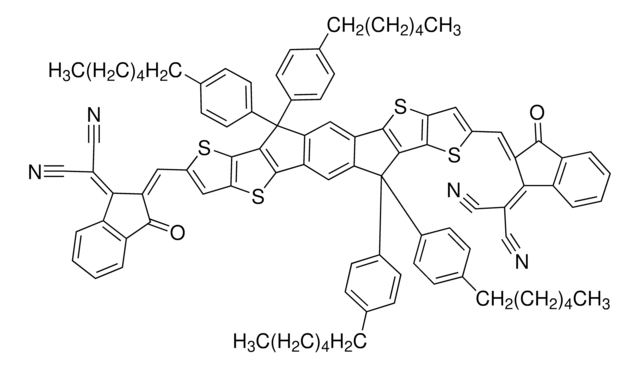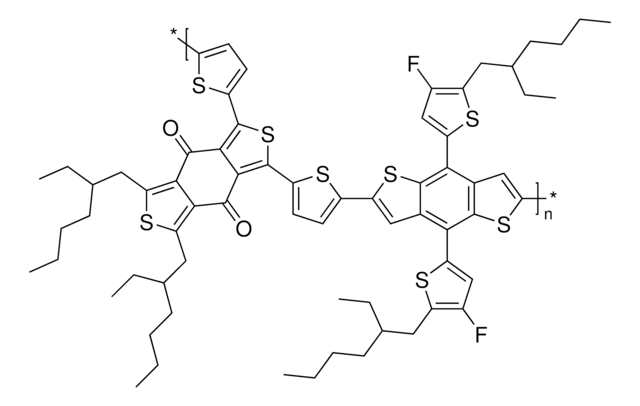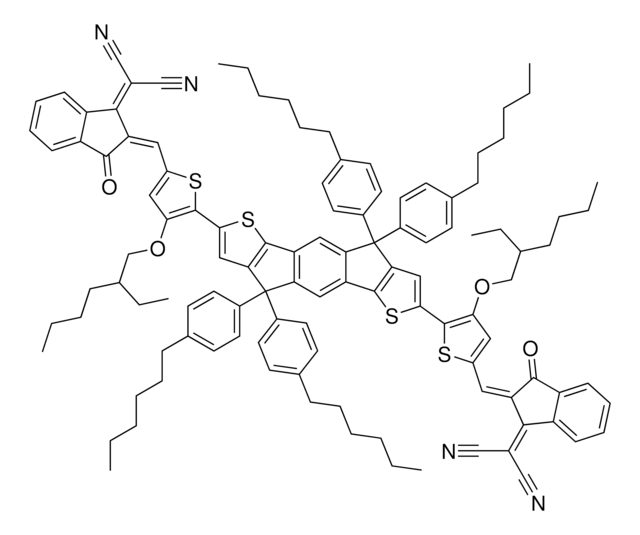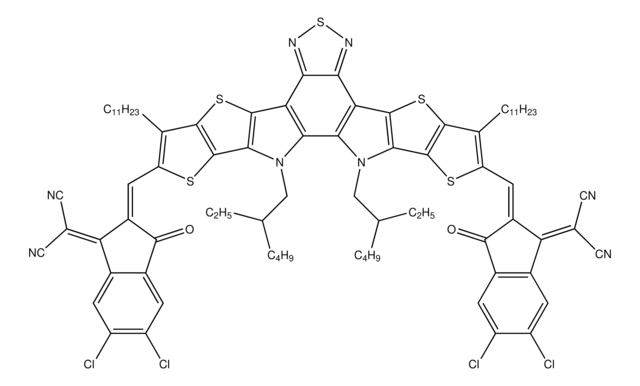910635
IDT-2Br
≥99%
Synonyme(s) :
5,5′-[[4,4,9,9-Tetrakis(4-hexylphenyl)-4,9-dihydro-s-indaceno[1,2-b:5,6-b′]dithiophene-2,7-diyl]bis(2,1,3-benzothiadiazole-7,4-diylmethylidyne)]bis[3-ethyl-2-thioxo-4-thiazolidinone], IDT-BT-R
About This Item
Produits recommandés
Description
Band gap: 1.83 eV
Essai
≥99%
Forme
solid
Poids mol.
1518.20 g/mol
Couleur
dark
Solubilité
chloroform: soluble
Énergie orbitale
HOMO -5.52 eV
LUMO -3.69 eV
Chaîne SMILES
S1\C(=C/c2c3n[s]nc3c(cc2)c4[s]c5c(c4)C(c8c5cc9c(c8)c%10[s]c(cc%10C9(c%15ccc(cc%15)CCCCCC)c%14ccc(cc%14)CCCCCC)c%11c%12n[s]nc%12c(cc%11)\C=C%13/SC(=S)N(C/%13=O)CC)(c7ccc(cc7)CCCCCC)c6ccc(cc6)CCCCCC)\C(=O)N(C1=S)CC
InChI
1S/C88H88N6O2S8/c1-7-13-17-21-25-55-29-39-61(40-30-55)87(62-41-31-56(32-42-62)26-22-18-14-8-2)69-51-68-70(52-67(69)81-71(87)53-73(99-81)65-47-37-59(77-79(65)91-103-89-77)49-75-83(95)93(11-5)85(97)101-75)88(63-43-33-57(34-44-63)27-23-19-15-9-3,64-45-35-58(
Clé InChI
MZMPYGNPOJDPIE-UJANMLRWSA-N
Description générale
Application
Ternary blend organic solar cells (OSCs) with photoresponses beyond 1000 nm can be fabricated using PTB7-Th as donor and ultralow-bandgap F8IC and medium-high bandgap IDT-2BR as NFAs. A PCE of 12.1% has been achieved by such a ternary device with 20% IDT-2BR content in acceptors. In this work, IDT-2BR was found to contribute simultanously to the improvement of the open-circuit voltage (VOC), short-circuit (JSC) and fill factor (FF) of the PTB7-Th/F8IC blend, due to smaller energy offset for charge separation, suppressed charge recombination, and imporved light absorption. Improved packing due to the coexsitence of F8IC and IDT-2BR leads to higher mobilities and more balanced charge transport, which contribute to the improved FF as well.
Additionaly, blends with IDT-2BR have been found to be thermally stable at 150 Celsius.
A ternary blend using both IDT-2BR and fullerene based acceptor: PC71BM (Product No. 684465) has also reached a PCE over 12%.
Code de la classe de stockage
13 - Non Combustible Solids
Classe de danger pour l'eau (WGK)
WGK 3
Point d'éclair (°F)
Not applicable
Point d'éclair (°C)
Not applicable
Faites votre choix parmi les versions les plus récentes :
Certificats d'analyse (COA)
It looks like we've run into a problem, but you can still download Certificates of Analysis from our Documents section.
Si vous avez besoin d'assistance, veuillez contacter Service Clients
Déjà en possession de ce produit ?
Retrouvez la documentation relative aux produits que vous avez récemment achetés dans la Bibliothèque de documents.
Articles
The emerging organic photovoltaic (OPV) technology is very promising for low-cost solar energy production.
The emerging organic photovoltaic (OPV) technology is very promising for low-cost solar energy production. OPV devices can be produced using high-throughput, large-volume printing methods on lightweight and flexible plastic substrates, making them easy to deploy and use in innovative ways.
Professor Chen (Nankai University, China) and his team explain the strategies behind their recent record-breaking organic solar cells, reaching a power conversion efficiency of 17.3%.
Notre équipe de scientifiques dispose d'une expérience dans tous les secteurs de la recherche, notamment en sciences de la vie, science des matériaux, synthèse chimique, chromatographie, analyse et dans de nombreux autres domaines..
Contacter notre Service technique


![Poly[(9,9-dioctylfluorenyl-2,7-diyl)-co-bithiophene] 99.9%](/deepweb/assets/sigmaaldrich/product/structures/309/000/8b4a3f54-7765-4aca-96c4-74ce328d455d/640/8b4a3f54-7765-4aca-96c4-74ce328d455d.png)




